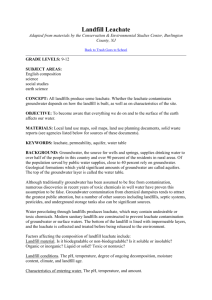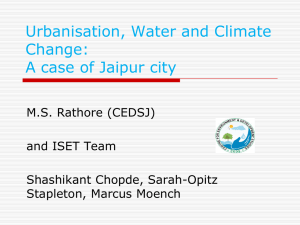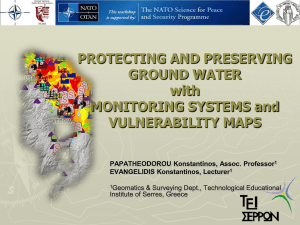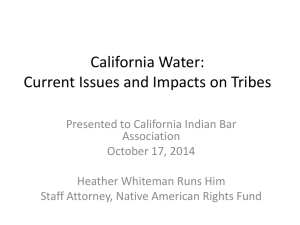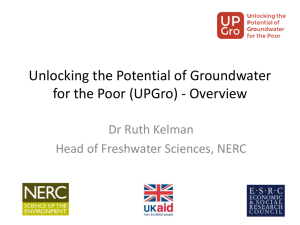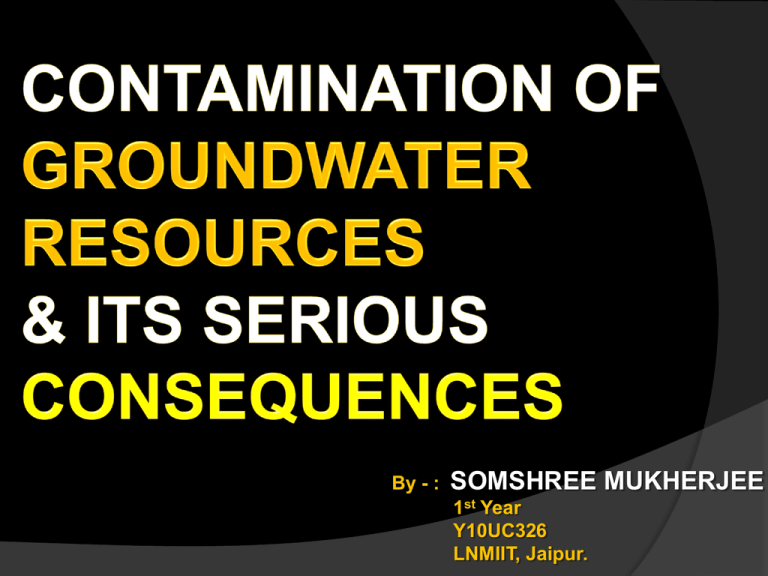
By - :
SOMSHREE MUKHERJEE
1st Year
Y10UC326
LNMIIT, Jaipur.
The story of water, is in many ways, the story of life itself…
Water is a vital natural resource which must be
utilized optimally, ‘harvested’, recycled, conserved,
prevented from getting polluted and properly
channelized for sustainable development
GROUNDWATER RESOURCES : How it gets polluted
There can be several ways by which the groundwater can get polluted.
Here, I have covered the two main sources of groundwater contamination.
1. Through non-engineered open landfills
2. Through an increment in the soak pit density, resulting from
the increasing population of an area.
In order to study the aforementioned causes of
Groundwater pollution, two case studies were done :
1. Contamination of groundwater resulting from increasing
density of soakpits due to increasing population.
PLACE : Dehradun city
2. An open landfill area causing groundwater pollution due to
leaching of toxic materials through the earth
PLACE : Outskirts of Jaipur city, along Agra Road, near LNMIIT
campus.
CASE STUDY : 1
Contamination of groundwater resulting from
increasing soakpit density due to increasing
population.
PLACE : Dehradun city
HISTORICAL BACKGROUND
* According to “Skanda Purana”, Dun formed a part of the region called
Kedar Khand.
* The city derives its name from “Dehra” or “Dera” signifying temporary
abode or camp.
* The term “Dun” or “Doon” means the low lands at the foot of a
mountain range
* Derivation of the term Dun or Doon is stated to be from Dronashram,
hermitage of Guru Dronacharya of Mahabharata fame, who sojourned
for a season in the village of Devra, situated near Dehra to perform his
devotion at a lovely spot at the foothills of the Himalayas.
* It is now the capital of the newely carved hill state of Uttarakhand.
DEHRADUN CITY
Location
:
Longitude:
Latitude:
78o00’E
30o15’N
- 78o10’E
- 30o25’N
Topography :
Sub-montane valley floor with uneven topographic surface and are also dissected by
number streams.
Southeast trending streams associated with Bindal, Song and Rispana rivers that drain
into Ganga, and the northwest-ward flowing streams associated with Asan river that
drain into River Yamuna.
Climate and Rainfall
The climate of Dehradun is generally temperate.
Extreme temperature variation. The heat is often intense during summer (max400C) and
it drops down to 2-30C during winter.
Substantial Rainfall. Average annual rainfall is 2054mm with 75 rainy days.
Area and population
•The total Area under the municipal city limit is 52 sq. km
•Total Population according to recent census (2001) is 447808.
P o p u la tio n (T h o u s a n d s )
• Highest population growth rate: 65% (Approximately 50 persons per day)
500
??
450
400
P O P U L AT IO N E X P L O S IO N
350
300
250
200
150
100
50
0
1891
1911
1931
1951
1971
C e n s u s Ye a r
1991
2011
# I observed that students are frequently absent from school
because of illness at some point of time in the year.
# As observed, it so happens that almost every child today has been
affected by some water-borne disease (WBD) at some point of their
life, be it jaundice, typhoid, dysentery, cholera, amoebiasis, etc.
# So I decided to conduct a demographic survey to find out
whether these diseases were locality-specific or spread out through
the entire city.
# For this, I conducted a survey at school, at Doctor’s clinic and also
at chemist shops.
# They were given questionnaires in which they were asked their
age, the WBD that they had had(if any and the year of occurance )
and the locality in which they lived.
W H A T A R E O U R A IM S ?
• T o c a rry o u t d e m o g ra p h ic su rv e y o n th e
in c id e n c e o f w a te r b o rn e d ise a se to
id e n tify th e re g io n s th a t a re m o re
a ffe c te d .
• T o lo o k in to th e w a te r re so u rc e s a n d
su p p ly sy ste m fro m so u rc e to e n d - u se r, to
in fe r th e p o ssib le so u rc e o f c o n ta m in a tio n .
• T o fin d o u t w a y s to p re v e n t th e w a te r
su p p lie s fro m c o n ta m in a tio n
METHODOLOGY
D e m o g ra p h ic s u rv e y
A t sch ool L evel
E ach stu d en t w as ask ed to
p rovid e follo w in g
in form ation :
1.
N u m b e r o f F a m ily m e m b e r s :
2.
N u m b e r o f p e r s o n s s u ffe r e d
fr o m w a te r b o r n e d ie s e s , th e ir
a g e , a n d m o n th o f s u ffe r in g
a n d ty p e o f d is e a s e d u r in g la s t
c o u p le o f y e a r s .
3.
4.
D o th e fa m ily u s e tr e a te d o r
u n tr e a te d
ta p
w a te r
fo r
d r in k in g p u r p o s e ?
R e s id e n tia l lo c a tio n / a d d r e s s
A t D octor’s C lin ic an d
C h em ist’s S h op
D octor or th e sh op o w n er
w ere ask ed to record th e
W ater B orn e D isease cases
for ab ou t a w eek
1.
N a m e o f d is e a s e
2.
Age and Sex
3.
D o th e fa m ily u s e tr e a te d o r
u n tr e a te d
ta p
w a te r
fo r
d r in k in g p u r p o s e ?
4.
R e s id e n tia l lo c a tio n / a d d r e s s
RESULTS–I:
Survey at School
Distribution of WBD: No specific locality is more affected
Seasonal Variation: Most of the cases of Typhoid and Jaundice occurred during the summer and
rainy season.
Su r ve y at Sch o o l
W at e r Bo r n e Dis e as ( W BD)
N- W BD
( 153)
W BD ( 58)
73%
27%
Su r ve y at Sch o o l
W BD T yp e ( n =58)
Other
14%
Ty ph
43%
Out of the 208 families, 58 cases
from 55 families reported WBD
during the past 18 months.
WBD Type Distribution
23 typhoid
23 Jaundice
10 Others
Jaun
43%
25
Su r ve y at Sch o o l
23
A g e V s . W BD
23
20
15
4
10
2
O the r
2
5
2
0
J a un
Typh
C hild(< 15)
adalts(> 15)
AGE Vs. WBD
Typhoid and Jaundice seems to be
restricted to children below the age of 15
years.
There are only 6 cases of WDB among the
adults of more than 15 years of age (2 cases
each of Amebiosis, typhoid and jaundice
only).
RESULTS–II:
Survey at Clinics
TOTAL 75 CASES reported at 3 clinics
with in 10 days (Mid October, 04)
S ur ve y a t Clinic s
Tota l W BD = 7 5
T yp h
25%
Ot h e r
64%
Jau n
11%
S urvey at C linics
•Typhoid
•Jaundice
•Others
= 19
=8
= 48
(Others: Gastroenteritis, Diarrhoea & Dysentery)
71 (95%) cases of WBD among Children
below 15 Years age group
Typh+Jaun
Total = 19
A d u lt
5%
C h ild r e n
95%
Typhoid and Jaundice in children (<15
yrs) = 18
Contrary to the survey at school, incidence
Typhoid and Jaundice cases are significant even
during this time (i.e. October).
Conclusions:
•The WBD is more prevalent among the children of <15 years age.
•WBD is spread all over the city. No specific locality is more affected.
•Most of the cases of Typhoid and Jaundice occurred during the summer and
rainy season
•However, incidence Typhoid and Jaundice cases are significant even during
other times of the year.
“Since WBD is caused by consumption of contaminated water, therefore,
there are sufficient reasons to believe that the Domestic water supplies in
Dehradun is contaminated at some stage from source to end users.”
Let’s have a look at the FRAGILE GEOHYDROLOGICAL
CONDITIONS OF DOON VALLEY
•Doon valley is an inter-mountane piedmont plain between the northern
Mussoorie and the southern Siwalik foothills.
•Sub-surface rocks consists of loosely packed gravel, sand and silty clay layers
up to ~600m thick, underlying the gravels, are the sandstones of Siwalik
formation.
•Doon gravels, having primary porosity and permeability, forms the main
aquifer in the area.
•The groundwater is present in multi-layered aquifers under unconfined
conditions and is characterized by high infiltration rate.
•The depth of water bearing zone is about 60-150 meter below the surface
DRINKING WATER RESOURCES of Dehradun City
Groundwater Resources
•Aquifers down to depths of 130-170 m.
• 52 tube wells in the urban areas and 8 tube wells in the rural areas
•82mld of water is pumped through these tube wells.
Surface water Resources
•Perennial sources:
1.Bandal river
2.Bijapur canal
3.Sahanshai canal
4.Rajpur canalm these resources
# As seen in the population explosion chart before, the
population of Dehradun city is increasing at an alarming rate
per day.
# This is resulting in more number of construction of houses
and hence there has been a drastic increase in the number of
soak pits in the city.
# As the population increases, the demand for water also
increases and so more and more tubewells are being dug to
pump out more of Ground Water .
# This may result in a serious condition of contamination of
the ground water as shown next, in a schematic sketch model
of how excessive pumping from the aquifer and increasing
density of soakpits are directly interlinked to groundwater
contamination.
Sketch model of groundwater contamination due to excess pumping
C o n ta m in a te d la y e r
Rive r va lle y
Depth (m eters)
0
100
M a in a q u ife r
200
300
Up p e r c o n ta m in a te d la ye r
G ra v e l la ye r
Silty-C la y la ye r
Sa n d y la ye r
F ig u re 7 . S k e tc h m o d e l o f g ro u n d w a te r c o n ta m in a tio n d u e t o e x c e s s p u m p in g .
T h e l s u b -s u rfa c e lith o lo g y s h o w n a re in d ic a tiv e o n ly.
This case study was done a couple of years ago, and the project as a
whole was also presented at the NATIONAL CHILDREN’S SCIENCE
CONGRESS on a National Level at Guwahati, Assam.
When this project was presented at the district level, the
Chief Executive of the Waterworks Department Of Dehradun
was also present, and after seeing the alarming figures and
photographs, a follow-up action was immediately executed
by her, wherein all leakages on pipelines were plugged and
also sewer pipelines have been laid all over the city so as to
prevent groundwater contamination through construction of
excessive soak pits.
Another major cause of Groundwater pollution is
unplanned landfills.
This topic crossed my mind while I was on my way
from college(LNMIIT) to Delhi by the Agra Road
(NH 11) around January 2011, and this is the
topic for my 2nd case study.
CASE STUDY : 2
An open landfill area that may cause
groundwater pollution due to leaching of toxic
materials through the soil.
PLACE : Outskirts of Jaipur city, along Agra Road,
near LNMIIT campus.
HISTORICAL BACKGROUND
* Jaipur, the pink city was founded in 1727 by Maharaja Jai Singh II, a
Kachhwaha Rajput, who ruled from 1699-1744.
* Jaipur is the first planned city of India and the King took great
interest while designing this city of victory.
* According to that time, architecture of the town was very advanced
and certainly the best in Indian subcontinent.
* Still, the neat and broadly laid-out avenues, painted in pink provide a
magical charm to the city.
* This city of victory really wins the hearts of the people with its
splendid charisma.
Location :
* Jaipur is the capital city of Rajasthan, a state in the
Northern part of India.
* The pink city would have been a part of Thar Desert, if
the Aravalli Hills have not separated them.
* As a result, Jaipur is located under the kind protection
of Aravalli Hills.
* Under the terms of geography, Jaipur extends from
latitude 26.92 degrees in the north to longitude 75.82
degrees in the east.
* The city covers an area of 200.4 sq kms and lies at an
altitude of 431 m above sea level.
Topography:
~ The general slope of the Jaipur city and its surroundings is from
north to south and then to south-east.
~ Nearly all the ephemeral streams flow in this direction. Higher
elevations in the north exist in the form of low, flat-topped hills of
Nahargarh (587 meters).
~ Jaigarh, Amber and Amargarh, which are deeply dissected and
eroded. An isolated hillock called “Moti Dungari” upon which an old royal
castle exists, is near the Rajasthan University.
~ Further in the south, topographical levels of the plain areas varies
between 280 meters along Bandi and Dhund rivers in the south to some
530 meters in the north east of Chomu near Samod hills.
~ The overall trend is a decline of level from the areas bordering the
hills in the north to plain in the south slopes of the plain areas are in
general gentle.
Drainage:
~ The natural drainage of the Jaipur city is largely technically affected.
~ It shows intense gully erosion particularly in the northern hilly region.
Dhund river and Amanishah nala form a fork like drainage pattern in the
confluence zone of which the major part of Jaipur city is situated.
~ The Amanishah nala, which originates from the western slopes of Jaigarh
hills, flows northwards in the upper reaches, turns south and south-west in its
middle course and flows towards east with a broad semi-circle.
Finally it joins river Dhund further down stream.
~ There is another small drainage system in the north foothills which now a
days discharges the city’s waste effluents into an artificially impounded lake
called the Jal Mahal (Man Sagar).
~ Jal Mahal lake is a large cesspool now of effluent waste water changing its
profile from muddy water mixed with effluents and sludge during rainy season
to a dried large puddle surrounded by parched earthen floor during summer
seasons.
Solid waste management is one of the most
challenging issues in urban cities, which are
facing a serious pollution problem due to the
generation of huge quantities of solid waste.
In a majority of the urban centers, waste is
disposed off by deposition in low-lying areas, and
uncontrolled land filling is practiced in most of the
cities. The disposal sites are selected on the basis of
their proximity to the collection areas, and new
disposal sites are normally identified only when the
existing ones are completely filled up. In most
cases, the waste is simply dumped at such sites and
bulldozers are rarely used for compaction at the
disposal site
# Landfills have been identified as one of the major threats to
groundwater resources
# Waste placed in landfills or open dumps are subjected to either
groundwater underflow or infiltration from precipitation.
# The dumped solid wastes gradually release its initial interstitial
water and some of its decomposition by-products get into water
moving through the waste deposit.
# Such liquid containing innumerable organic and inorganic
compounds is called ‘leachate’. This leachate accumulates at the
bottom of the landfill and percolates through the soil.
ENVIRONMENTAL PROBLEMS RELATED TO OPEN LANDFILLS
1. Provisions for leachate and gas control do not exist, and soil cover is rarely
provided except at the time of closure of the site.
2. Most of the disposal sites are unfenced and waste picking is commonly practiced,
posing problems for controlled operation of the sites.
3. The landfills are not lined, compaction of waste is not carried out, and soil cover is
also not applied over the waste.
4. As a result, the landfills create unhygienic conditions and cause degradation of
environmental quality.
5. In rainy seasons, rain water percolates through the waste and soil strata and
pollutes the groundwater.
6. Fly and mosquito breeding take place at the disposal sites.
7. Moreover, a smoke nuisance is caused by the unauthorized burning of waste
practiced by rag pickers
The pollution process : How the Groundwater is getting Contaminated
1. When rainfall soaks into waste in a garbage tip it slowly drains through the waste under
gravity.
2. As it does so it picks up soluble contaminants from the waste itself. This produces a very
strongly organically contaminated liquid which is called leachate.
3. Most of the contamination is biological (organic) in nature, but whatever soluble
contaminants are present in the landfill, the leachate will probably also contain them in small
quantities.
4. The leachate will also have dissolved methane in it if it comes from a gassing (biogas
producing or methanogenic) landfill.
5. The leachate will drain away through any reasonably permeable material which exists under
the landfill. Although this material below the landfill may do some filtering and further cleansing
of the leachate, it can enter the underground strata still in a highly polluting condition.
6. Any groundwater which gets polluted will still keep flowing underground and although the
ground may help to naturally filter and biologically treat the leachate, eventually the pollution
flow may grow and the small extent of a polluted area shown initially may later have to be
extended if a growing contaminant plume develops, and nearby water resources including water
supply boreholes can be contaminated.
Schematic diagram for leaching of Contaminated Soil into the Aquifer
If the Groundwater gets contaminated once, it will
probably remain unusable for several generations.
Such a loss of something as precious as water is a
terrible problem for later generations.
Waste quantity generation rate (a) waste quantity (TPD) vs cities (b) waste generation rate
(kg/c/day) vs cities (c) waste category vs cities
Taking up a specific Open landfill site in
Jaipur, that stretches for a couple of
square kilometers, along Agra Road
(NH 11), let’s have a look at some of
the images taken up from Google
Earth maps.
Land fill area
along Agra Road
The landfill is mainly distributed
in two parts. The nearest one is
approximately only 1.30 km
from The LNMIIT campus !!!!
LNMIIT
Campus
The Land filling Site covers
a huge area and is located
amidst agricultural fields
around it !!
The two land fills are located at a
proximity of 0.3 km
The Waste disposal site
covers an enormous area
Moreover, the landfills stand extremely
close to the River hence polluting the
river water as well. This River water is
used for irrigation purposes in the
fields and also for drinking purposes in
many of the nearby villages
It spans 1.67km along the Agra
Road and almost 0.32 km in width
~~~ The site is non-engineered low lying open dump, looks like a
huge heap of waste up to a height of 12–20 m. Trucks from
different parts of the city collect and bring waste to this site and
dump the waste in irregular fashion. The waste is dumped as such
without segregation, except the rag pickers who rummage
through the garbage and help in segregating it.
~~~ The extent of contamination of groundwater quality due to
leachate percolation depends upon a number of factors like
leachate composition, rainfall, depth and distance of the well
from the pollution source, the landfill site in the present case.
~~~ The gravitational movement of the viscous fluid, leachate is
hindered due to the mass of the solid soil matter.With increasing
time the viscous fluid penetrates deeper and spread all over a
longer distance.
Let’s have a look at some statistics of the population of Jaipur :
Jaipur population
Census
1981
1991
2001
Est. 2013
i.e.
Pop.
1,015,200
1,518,200
2,210,800
5,000,000
%±
—
49.5%
45.6%
126.2%
189.7534 persons per day came into
the city everyday for 10 years from 1991 to 2001.
Source: Census of India[8]
As we can see , that, as the population of Jaipur
increases at this alarming rate, the total solid waste
that would be produced everyday will go on
increasing and hence these landfills will become
even worse !!
* Areas near landfills have a greater possibility of groundwater
contamination because of the potential pollution source of leachate
originating from the nearby
site.
* Such contamination of groundwater resource poses a substantial
risk to local resource user and to the natural environment through air
pollution, soil pollution and water pollution.
* Many approaches can be used to assess the contamination of
underground water. It can be assessed either by the experimental
determination of the impurities or their estimation through
mathematical modeling
This Agra Road landfill site is non-engineered landfill. It is neither having
any bottom liner nor any leachate collection and treatment system.
Therefore, all the leachate generated finds its paths into the surrounding
environment. In such conditions only feasible options that could be followed
are:
(i) Limiting the infiltration of the water through the landfill cover by providing
impermeable clay cover. Due to this lesswater will enter and subsequently
less leachate will be generated, thereby reducing the amount of leachate
reaching the landfill base.
(ii) Extraction of the leachate collected at the base can be done and it can
be recycled, so that less amount will enter the aquifer lying below.
(iii) Increasing the evapo-transpiration rate by providing vegetation cover
over the landfill can also reduce leachate production.
Let’s have a look at some of the
photographs taken of this place
while on a journey from Jaipur to
Delhi via the Agra road in
January 2011
There is a school also
for kids and many
houses and shops in
this area !!!!
Direct Consequences to LNMIITians !!!
* With the direction of flow of air, the foul smell from the landfill garbage heaps
sometimes also make their way into the college atmosphere, polluting it.
* The direction of the river branching in the map shows the slope of the land to be from
the landfill area towards the LNMIIT campus.
* Therefore, the Groundwater flow direction and the surface water flow directions are
toward the college campus which is a serious threat to the students living here and also the
villages around.
* For this, the groundwater quality should be kept under regular monitor so as to check
for any changes in the purity levels of the groundwater, so that, if necessary, steps can be
taken to control further damage and pollution of the Aquifer there.
CAUTION !!!
IMAGINE !!! If the aquifer is contaminated…
Do we have any technology to clean up the aquifer?
The micro-organism would grow
and multiply. The valuable
groundwater shall become
unusable.
ACT NOW AND SAVE THE CITY FROM SUCH A DEVASTATION

